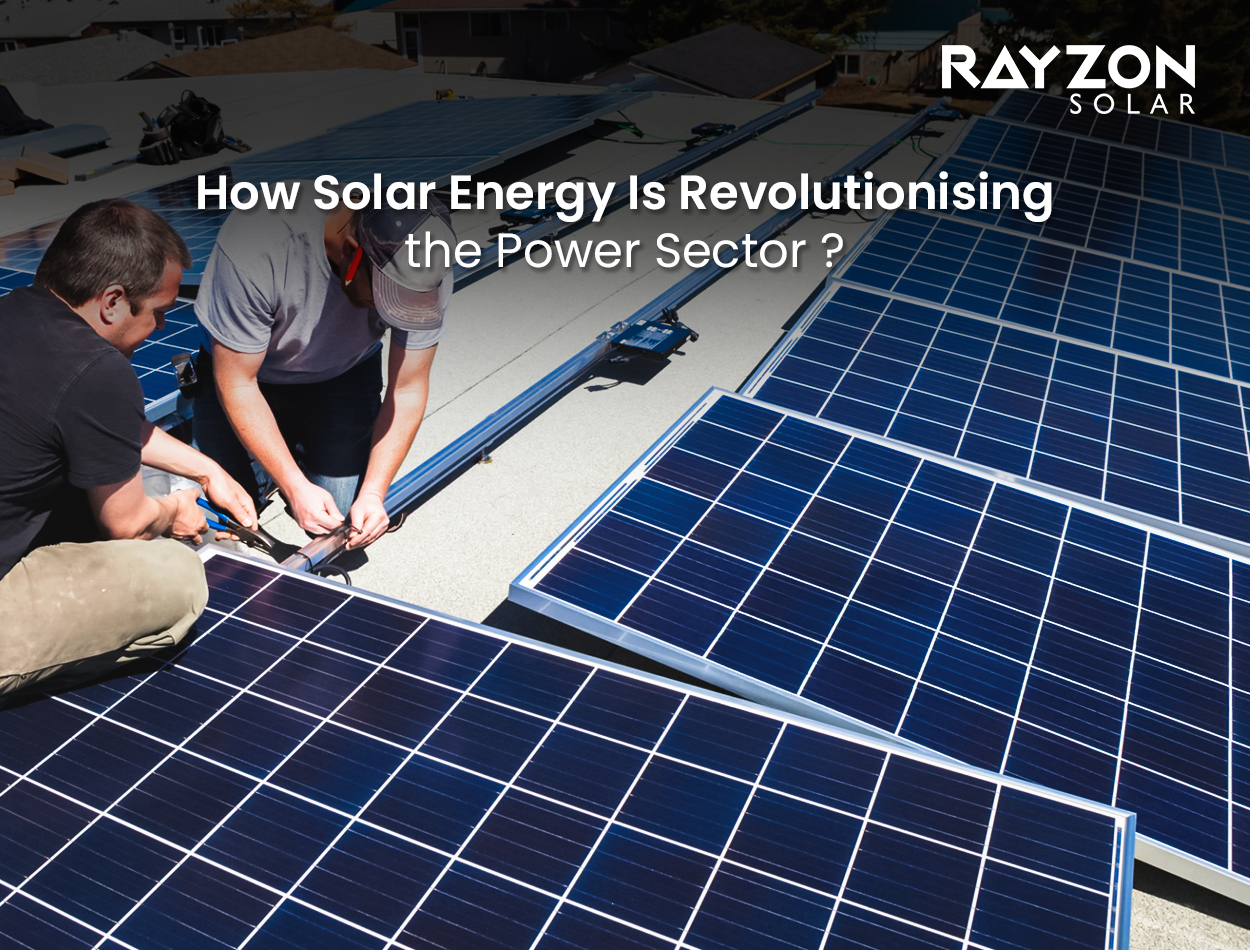
How Solar Energy Is Revolutionising the Power Sector
The global energy landscape is undergoing a seismic shift. Solar energy in the power sector is emerging as the cornerstone of a sustainable future, reshaping how electricity is generated, distributed, and consumed. In India and around the world, the solar power revolution is fueled by cutting-edge technologies, favourable policies, and the increasing awareness of climate change.
As nations transition from fossil fuels to clean energy solutions, India, solar energy has become the linchpin for renewable energy trends 2025, driving massive change in the power sector. With solar industry growth, India is projected to reach unprecedented levels by 2030, and the future of solar energy is brighter than ever.
In this blog, we will explore the transformative journey of solar energy, the latest solar technology advancements, and the many benefits of solar energy in electricity. We’ll also compare solar vs traditional power and understand why solar is rapidly becoming the preferred choice for households, industries, and governments alike.
The Rise of Solar Energy in the Power Sector
The solar energy transformation in the power sector is not just a trend – it’s a necessity. Global energy demands are skyrocketing, and traditional fossil fuels are depleting while contributing to greenhouse gas emissions. Solar energy provides a clean, renewable, and limitless energy source, making it a perfect alternative for both developed and emerging economies.
In India, initiatives like the Surya Ghar Yojana are propelling the adoption of solar power at a national scale. Solar industry growth in India has been supported by government subsidies, net-metering policies, and investments in solar infrastructure. This has led to a rapid transition from traditional power generation to solar-based systems.
Solar Power Revolution: A Global Perspective
The solar power revolution is visible across continents. From vast solar farms in deserts to rooftop solar panels in cities, solar energy is proving its capability to generate affordable and clean electricity. Unlike fossil fuel plants, solar installations have minimal environmental impact and offer energy independence.
India stands at the forefront of this revolution, supported by top manufacturers like Rayzon Solar. With advanced photovoltaic technology and high-efficiency solar panels, India is not only fulfilling domestic demand but also exporting solar modules globally.
Solar Energy and Economic Transformation
The adoption of solar energy in the power sector is not just an environmental shift but also an economic revolution. By reducing dependency on fossil fuels, countries can save billions in fuel imports while creating thousands of jobs in solar panel manufacturing, installation, and maintenance. This economic transformation is particularly evident in India, where the solar industry is fostering entrepreneurship and local business growth.
Government-backed initiatives, like Make in India, have encouraged domestic solar industry growth India, making the nation a global hub for solar module exports. Companies like Rayzon Solar are leading this charge by delivering high-efficiency panels and sustainable energy solutions, helping both rural and urban communities access affordable power.
Integration of Solar with Smart Grids
The future of solar energy lies in its seamless integration with smart grid technology. Smart grids enable better management of electricity distribution, ensuring that solar-generated power is efficiently stored and used. With the growing demand for clean energy solutions India, hybrid solar grids are becoming essential for balancing power generation and consumption, especially during peak hours.
Additionally, the incorporation of AI-driven analytics allows utilities to predict energy demand patterns and optimise solar energy storage. As outlined in our blog on Monitoring Solar Energy Systems, advanced monitoring tools are improving grid stability and reducing energy wastage, further accelerating the solar power revolution.
Solar for Industrial and Commercial Applications
Industries and large commercial establishments are embracing solar as a primary source of energy. By switching to solar, businesses can significantly cut operational costs and achieve sustainability targets. The benefits of solar energy in electricity are particularly attractive for energy-intensive sectors like manufacturing, where solar power can replace traditional grid electricity at a lower long-term cost.
Commercial setups are also exploring Ground-Mounted Solar Projects and rooftop solutions to optimise energy savings. With solar vs traditional power, companies can achieve substantial savings on energy bills while reducing their carbon footprint – a key aspect of modern corporate responsibility.
Solar Energy and Rural Electrification
One of the most remarkable impacts of solar energy transformation is in rural areas where conventional grid connectivity is limited. Off-grid solar systems are empowering remote communities with reliable electricity, driving education, healthcare, and local businesses. Programs like Community Solar have made renewable power accessible to underserved populations.
Furthermore, solar energy supports agricultural needs by powering water pumps and cold storage systems. As India’s renewable energy trends 2025 unfold, solar will continue to be a game-changer in improving the quality of life in rural regions, while simultaneously fostering economic opportunities.
Environmental Impact of Solar Energy
Unlike fossil fuel-based electricity generation, solar energy produces no harmful emissions, making it an environmentally friendly solution. The clean energy solutions India movement highlights solar power’s critical role in mitigating climate change by reducing carbon dioxide and particulate matter emissions. Solar panels also require minimal water for operation, unlike thermal plants.
In addition, the solar technology advancements in recycling and reusing older panels ensure that solar energy remains sustainable throughout its lifecycle. For example, the Solar Panel Recycling Process is becoming a vital component of the industry, minimising waste while maximising energy efficiency.
Key Drivers of Solar Industry Growth in India
- Government Initiatives: Schemes like PM-KUSUM and various government solar subsidies are encouraging large-scale adoption.
- Technological Advancements: Topcon technology and bifacial solar panels are improving energy output.
- Cost Reduction: The declining cost of solar modules and installation makes solar energy affordable for households and industries.
- Corporate Sustainability Goals: Companies like Rayzon Solar are spearheading the corporate shift towards green energy.
Benefits of Solar Energy in Electricity
- Zero Fuel Cost: Once installed, solar panels generate free electricity from sunlight.
- Environmental Benefits: Solar power significantly reduces carbon footprints compared to traditional coal plants.
- Energy Independence: Countries can reduce their reliance on imported fuels.
- Grid Stability: With energy storage solutions, solar energy ensures an uninterrupted power supply.
- Economic Growth: The solar sector creates jobs, fosters innovation, and boosts local economies.
For a detailed analysis, explore the Benefits of Solar Energy.
Solar vs Traditional Power
When we compare solar vs traditional power, the advantages of solar become clear. Traditional energy sources like coal and gas are finite and heavily polluting, whereas solar is renewable, scalable, and sustainable. Additionally, solar power plants have lower maintenance costs and can be deployed quickly in both urban and rural settings.
For insights on solar savings, check How Solar Panels Reduce Electricity Bills.
Renewable Energy Trends 2025: What’s Ahead?
- Energy Storage Integration: Solar + battery systems will dominate residential and commercial setups.
- Floating Solar Farms: India is exploring large-scale floating solar projects on water reservoirs.
- Smart Solar Grids: The integration of AI and IoT in solar power management.
- Hybrid Energy Systems: Combining solar with wind and other renewables for an uninterrupted power supply.
Learn about Solar Role in Net-Zero Cities 2025 for more insights.
Solar Technology Advancements
Solar technology advancements are revolutionising panel efficiency and lifespan. Innovations like bifacial technology, perovskite solar cells, and transparent solar panels are setting new benchmarks in energy generation. By 2025, solar panels are expected to achieve over 25% conversion efficiency, significantly reducing the cost-per-watt.
The Future of Solar Energy
The future of solar energy is not just promising – it’s inevitable. With nations committing to net-zero emissions, solar energy will play a central role in global electrification. In India, solar power is expected to surpass 300 GW by 2030, creating a robust clean energy ecosystem.
Internal Links for Deeper Insights
- Learn how Maximizing Solar Panel Efficiency can boost energy output.
- Explore Rayzon Solar Milestone Story to understand India’s solar journey.
- Check out The Manufacturing Process of Solar Panels for insights into modern solar production.
- Read about Solar Energy Meets Electric Vehicles to see future synergies.
Conclusion
The solar energy transformation is redefining the power sector globally. From reducing carbon emissions to providing cost-effective electricity, the benefits of solar energy in electricity are unmatched. India’s solar industry growth is a testament to how clean energy solutions can shape a sustainable future.
By embracing solar technology advancements and understanding the future of solar energy, both individuals and organizations can contribute to a greener planet.
With these emerging trends and innovations, solar energy is undeniably redefining the global power sector. From rural electrification to industrial applications, the solar power revolution promises a cleaner, greener, and economically stronger future. By leveraging solar technology advancements and staying ahead of renewable energy trends in 2025, India is positioning itself as a leader in the global clean energy movement.



